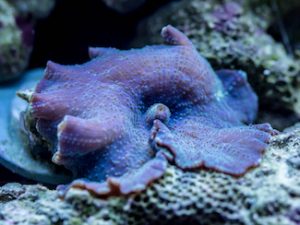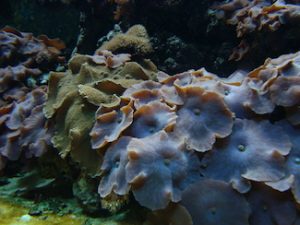

| Difficulty | Water Parameters | Base Supplements | Aggression | Lighting | Waterflow | Placement |
| Easy | 72-78 F, pH: 8.1-8.4, Salinity: 1.023-1.025 |
Trace Elements, Iodine | Semi-Agressive | Moderate | Low to Medium | Anywhere |
Mushroom corals are some of the most versatile corals available to keep. Mushroom corals can maintain good health in less than ideal water parameters, making them a top pick for aquarium beginners. Mushroom corals are not too picky either; they can be placed most anywhere in your tank with low to medium lighting and water movement. Mushroom corals will enlarge when they are happy with their placement, making it clear whether they are happy where they are or not.
Mushroom corals come in many colors including red, blue, pink, and green. They also come in a variety of designs including poka dotted, striped, and solid colored. Mushroom corals are great for building a reef tank because they are easy to breed and spread throughout your aquarium. They will produce new mushrooms easily, and your rocks will become decorated in these gorgeous and colorful caps.
Placement
Mushroom corals are forgiving with tank placement for the most part. Mushroom corals should be placed on live rock or rock rubble as they will attach themselves there. Mushroom corals like to stay mostly towards the bottom to middle of the tank so that they get low to medium lighting. All powerheads and water movement sources should not be directed at the mushroom corals, because they do not like strong water flow. Give your mushroom corals a small amount of indirect water movement. You will know that your mushroom corals like their tank placement when they expand in cap size. It will take them up to a few days to adjust to your tank after adding them. It can be noted that having some blue actinic lighting will make the colors of the mushroom color more vibrant.
Feeding & Supplements
Mushroom corals do not need to be manually fed if your tank is healthy. Mushroom corals will filter feed off marine algae known as zooxanthellae, phytoplankton, and waste particles in your water to get the nutrients they need. Large mushroom corals can sometimes be fed small meats such as brine shrimp as a food supplement. It is to be noted that giant species of mushroom corals such as the Rhodactic and Amplexiduscus are known to be able to capture small prey and fish. Do not keep these two mushroom corals unless your tank inhabitants are relatively large.
Most mushroom corals do not need to be supplemented with nutrients as they get most they need from the water. However, if your mushroom coral is looking a bit ill, supplements may be of use. Different species of mushroom corals will need specific supplements, so look up which kind you have. Common supplements mushroom corals may need are iodine, magnesium, calcium, and strontium. If your mushroom corals are looking sick, it is also a good thing to do a 20% water change. Excessive nutrients, namely phosphates and nitrates, can be severely damaging to mushroom corals.
Compatibility
Most species of mushroom corals are compatible with most other coral and fish. Mushroom corals can move around slowly, so they should be placed a fair distance away from other corals in your tank to prevent a food fight that may cause one of them to fall ill. Mushroom corals are labeled semi-agressive, but generally speaking, they are peaceful. It is wise to not have coral eating inhabitants such as peppermint shrimp, triggerfish, and puffers because these usually like preying on mushroom corals. Many times, if you keep coral-eating inhabitants in your tank with mushroom corals, the mushroom corals will get stressed and gradually wilt away.
Mushroom corals are to be watched with a close eye because they will reproduce quickly. Make sure they do not get huge and encroach on a neighbor coral’s space. If needed, you can cut the mushroom off the rock and move it to another location.
Reproduction & Breeding
Mushroom corals can reproduce in four natural ways:
-
- Sexual Reproduction: Eggs and sperm from mushroom corals will be released into the water. They will unite, and settle onto your substrate. Usually you will not reproduce mushroom corals this way because either your filtration system will suck the larvae up, or your fish will eat them before they get a chance to grow.
-
- Laceration: When your mushroom corals move slightly around your tank, they may leave a small piece of mushroom coral behind. This piece will grow into an entire new mushroom coral.
-
- Fission: A mushroom coral will get large and split itself down the center and through the mouth, forming two mushroom corals instead of one.
- Budding: Your mushroom coral will form a tissue particle off itself. This particle will grow into a new mushroom coral.
You can also propagate your own mushroom corals pretty easily. Follow these steps to do so:
a) Using a sharp scalpel, remove a large mushroom coral from your tank, cutting it from the bottom.
b) Cut the mushroom in half directly through the mouth in the center. You can also cut these halves in half to create four mushroom corals.
c) Place the new mushroom corals on loose rubble in a cup. Make sure the waterflow is low or they will not attach themselves. Leave them there for a couple days so they have time to attach. You can have them reattach in an isolation tank with the same water as your tank to destress them.
d) Move the mushrooms attached to their rubble back to your display tank. If they have not yet attached, simply attach them to a rock using reef-safe glue.
Note: Mushroom corals will produce an unpleasant odor when breeding. Do not worry, this is normal. This is the smell of the mushroom corals’ toxins that they use to push other corals out of their way.